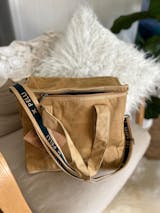
There’s just no escaping the harrowing truth our society faces at the moment: our earth is overwhelmed with plastic pollution. WWF report that in Australia alone, an average of 130kg of plastic is used per person, per year. The scary news? Only 12% of that plastic is recycled. We as consumers are now positioned in a monumental moment that could define the future not only for our generation, but for the ones to come after us. As we look toward a plastic-free world, it’s important that we understand what is available to them, and what is the best choice for a sustainable lifestyle.
Every material has a different impact when you evaluate its consumption of energy and water, as well as its ability to be recycled correctly. We’ve broken down the most common materials found in reusable bags, and analysed their ecological value so that you can make a more informed decision for yourself.
Calico
Unlike disposable bags, calico material is 100% reusable. Due to their thick and sturdy material, bags made out of calico are designed to last. Calico can also be dyed (with natural plant-based dyes) into a range of colours, but it’s natural cream colour highlights its natural fibres. Though they are designed to last for years on end (and can be cleaned with a gentle machine wash or hand wash), there will come a time when its life comes to an end. The great thing about calico bags is that they are 100% biodegradable! Many people choose to re-purpose their old calico totes, by turning the leftover material into clothing, furniture or homewares. Being one of the most versatile materials on the planet, there really is no limit to what calico can do!
Jute
The holy-grail of all sustainable ventures, we can’t praise jute enough. 100% biodegradable and compostable, jute is the world’s most eco-friendly material. This wonder-fabric uses the least amount of water and fertilizer out of all alternative materials. Better yet, this stuff grows in masses! Unlike precious resources like palm oil and silk, jute is not a material that we need to worry about losing. Bags made out of jute fabric are completely plastic free, petrochemical and paraben free, vegan and naturally organic! The very best part? When the lifespan of your gorgeous jute bags come to an end, the material can be disposed of in your compost where it will enrich the life of your plants and veggie garden!
Neoprene
A name you might not hear around town all that much, neoprene is largely used as a synthetic rubber material for water-use. Commonly used in wet-suits, car seat covers, gloves, hoses, mouse pads and more, neoprene is very versatile. A benefit of neoprene is its ability to insulate, as well as resisting burning, not to mention it degrades a lot less than natural rubber. Although you might not find as many reusable shopping bags made out of this material, it’s taken the upmarket fashion world by storm with many designers opting for the material due to its sleek texture. However, it should be stated that neoprene does not hold as much ecological value as its alternatives. It doesn’t have the “breathability” of materials such as jute and cotton, and requires a lot of production to make products.
PPL
PPL, more commonly known as polypropylene, is a type of plastic. Readily available and pretty inexpensive, this material is used in almost every plastic-based product you can think of. Medication bottles and food packages are almost always made out of PPL, due to its ability to resist moisture and positive chemical balance. Although this material is known to be reliable, it is certainly not the most eco-friendly. Polypropylene is highly flammable, as well as being susceptible to oxidation. However, the material can be recycled for new products – meaning it doesn’t have to be disposed of, as it doesn’t have degradable qualities and won’t break down on its own.
Washable Paper
Our new favourite fabric (and probably the coolest!), washable paper is the underdog of the reusable bag world. Washable paper is created from natural plant fibres and is 100% vegan and animal-free. Mimicking the look of real leather, washable paper provides that chic, expensive feel without the environmental impact. Rather, the material is actually completely plant-based and natural. Due to its natural state, it won’t wear out like synthetic leather, but instead will withstand harsh conditions to maintain it’s gorgeous texture. The best part? It can be washed! Designed to be used time and time again, this alternative to plastic bags ticks all the boxes.
With the phase-out of plastic bags slowly rolling out among the world (France is to join the revolution by 2021), consumers are looking for alternative options to the dire plastic bag. The thought of plastic pollution can be overwhelming, as can the thought of finding the right materials to do replace them. But the world doesn’t need 10 people living completely plastic-free – it needs 8 billion people, making intentional choices daily to fight for a cleaner future.
“We don’t have to engage in grand, heroic actions to participate in change. Small acts, when multiplied by millions of people, can transform the world.” – Howard Zinn.
X Pelli


